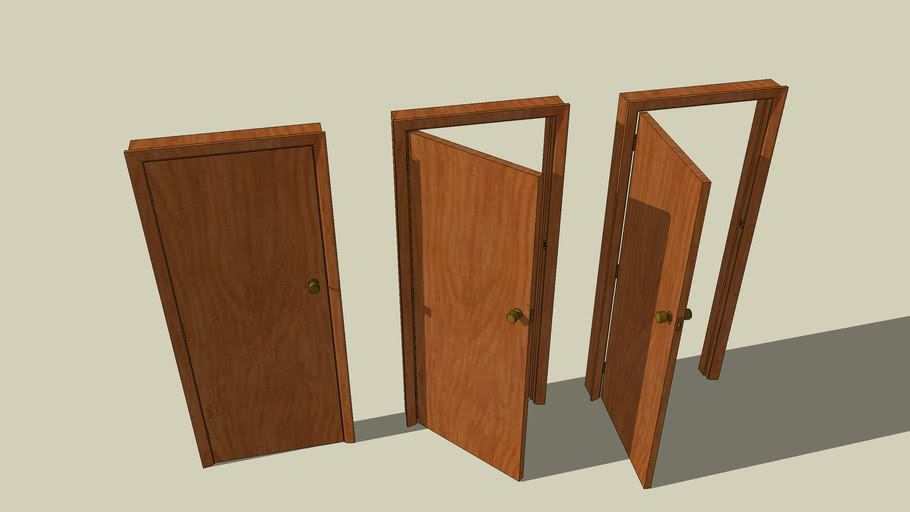
SketchUp is an incredibly intuitive and powerful 3D modelling software, suitable for anyone from architects and designers to simple DIY enthusiasts. Regardless of what type of structure you’re designing, one of the most common tasks you’ll find yourself having to do is the creation of a door. SketchUp enables you to create a whole host of door types, each bespoke to your exact requirements. In this article, we’re going to show you exactly how to make doors on SketchUp, bringing you through each and every step from the initial concept to the finished product, providing some tips and tricks to take your skills to the next level, and answering a host of the most common questions you might have about the process.
Step-by-Step Guide: How to Make Doors on SketchUp
Step 1: Create a Door Template
Before you can begin to think about creating the perfect door for what you require, decked out with all the custom modifications you need, you’ll have to create a door template. Once this is in place, you can then begin to shape it to your exact needs.
Follow these steps to create a door template:
- Open SketchUp, select the Rectangle tool, and create a rectangle.
- Select the Push/Pull tool and extrude the rectangle to the required thickness of the door.
- Select the Line tool and create a horizontal line across the middle of the door, creating two separate parts.
- Select the Push/Pull tool once again and create a groove along the line you just created. This will be the space for the door handle.
If you followed these steps, your door template will now be complete and your door is ready to be designed.
Step 2: Create a Basic Door
Now that you’ve made your door template, it’s time to create your first door — let’s keep it simple for now, using the following steps to create a basic door:
- Select the rectangle tool and create a rectangle inside the door template you made in the previous section. This will be the door panel.
- Use the Push/Pull tool to extrude the door panel to the required thickness.
- Use the Line tool to create horizontal and vertical lines on the door panel to represent the various panels.
- Select the Push/Pull tool once again and use it to create grooves along each of these lines, creating the door panels’ spaces.
By now, your door is really beginning to take shape. Let’s take a look at how we can make it a little more unique by modifying it even further.
Step 3: Modify the Door Design
SketchUp is packed with a whole host of powerful tools that allow you to modify every individual aspect of your designs. Here’s just the beginning of what you’re able to do — don’t be afraid to experiment with all of these tools to create exactly what you’ve envisioned! Take a look at some of our favourite tips:
- Use the move tool to adjust the size of the door panels to fit the look you’re going for.
- Try using the Scale tool to resize the panels in a uniform manner.
- The Rotate tool can be used to rotate the door panels, creating unique and quite striking designs.
- Select the Offset tool and use it to create bevelled edges or to add an extra layer of detail to the door panels.
These tools are just a few of the many available to you in SketchUp to take your door from basic to something more unique, intricate, and ultimately fitting of the project it’s part of.
Step 4: Add Door Hardware
You have your custom door complete, but something still seems missing. Of course, no door is truly complete without the correct hardware. Locks, hinges, and handles are what will truly round out your door, so let’s explore how to use SketchUp to add these vital components.
Follow these steps to add door hardware to your newly created door:
- You should already have a groove across the middle of your door from creating your door template, but if not, select the Line tool to add a horizontal line across the door, and create a groove using the Push/Pull tool. This is where the door handle will go.
- Use the Circle tool to create a circle inside this groove, representing the space for the door handle.
- Extrude this circle using the Push/Pull tool to create a basic handle.
- Select the rotate tool and rotate the handle to your desired position.
- Next, use the Line tool to create two lines on the door panel, representing the spaces for the hinges.
- Use the Push/Pull tool to extrude these lines, creating spaces for the hinges.
- Select the Rectangle tool and create rectangles on these spaces to create your hinges.
With these steps completed, you’ve now created a fully bespoke door fit with all the necessary hardware to function properly.
Tips and Tricks for Making Doors on SketchUp
Making a door on SketchUp is simple if you follow the steps we’ve outlined above, but here are a couple of extra tips that might help make the entire process even easier.
- Make sure you start with accurate measurements. If you don’t know your measurements, try and find a reference online so that you can keep the door fully proportional without resorting to guessing.
- Use layers while you work to organise your design, making it much easier to modify and edit.
- Don’t forget to utilise components.SketchUp’s component feature is fantastic for creating reusable elements such as handles and hinges. This will speed up your process while also keeping your design consistent.
- Use the Follow Me tool to create raised or recessed panels on your door, or to create more complicated designs such as arched doors. All you have to do is draw along the profile of a panel and then extrude it to create the desired look.
- The Scale tool can be used to create unique and asymmetrical designs, so make sure to experiment with it to understand exactly how this simple but powerful tool can add to your design.
- Enhance the realism of your door by applying textures and materials to your final design.
FAQs: How to Make Doors on SketchUp
Can I import door designs from other software into SketchUp?
Can I add glass to my door design?
Can I add texture or pattern to my door design?
Where can I find additional resources and support for SketchUp?
SketchUp is an incredibly versatile and powerful tool when it comes to designing and creating architectural and design elements. The steps in this article will have you well on your way to discovering the design possibilities SketchUp offers through the creation of one of the most common features you’ll need to master — the door. Now you should be able to make a template, create a basic door, and transform it into a customised piece of design work fit for your own personal project.
Our series of tips and tricks should help propel your skills to the next level by creating more intricate designs and by using features such as textures to make your work really stand out. Now that you know how to make a door in SketchUp, the next step is entirely up to you. Check out our website for some inspiration on your next project, where you’ll find a range of in-depth tutorials, detailed case studies, and a whole host of helpful blog posts to propel your SketchUp skills to the next level.



